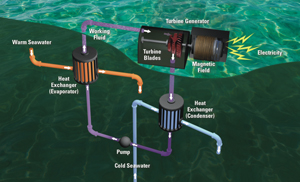Ocean Thermal Energy Conversion: An old idea worth new technology
 Ever since French physicist Jacques Arsene d'Arsonval first proposed tapping the ocean's thermal energy for power back in 1881, experts have proclaimed that Ocean Thermal Energy Conversion (OTEC) was an idea whose time would never come. Although there were small successes along the way, skeptics believed OTEC pioneers were tilting at windmills in their quest to make this environmentally friendly energy source on a large enough scale to help quench the world's thirst for electricity. The sheer size and economics of developing an offshore facility that could affordably and efficiently generate significant power have prevented d'Arsonval's dream from becoming a reality. But, the tide is finally turning.
Ever since French physicist Jacques Arsene d'Arsonval first proposed tapping the ocean's thermal energy for power back in 1881, experts have proclaimed that Ocean Thermal Energy Conversion (OTEC) was an idea whose time would never come. Although there were small successes along the way, skeptics believed OTEC pioneers were tilting at windmills in their quest to make this environmentally friendly energy source on a large enough scale to help quench the world's thirst for electricity. The sheer size and economics of developing an offshore facility that could affordably and efficiently generate significant power have prevented d'Arsonval's dream from becoming a reality. But, the tide is finally turning.
Understanding OTEC
The concept behind Ocean Thermal Energy Conversion is straightforward: OTEC simply leverages the temperature differential found in tropical waters to complete a power-producing cycle. OTEC systems require a 36 ° F (20 ° C) difference between surface and deep, ocean temperature. This temperature difference drives the system, much like a steam engine. Warm surface water pumped through a heat exchanger vaporizes a fluid with a low boiling point, such as ammonia, to drive a turbine generator that produces electricity. The cold, deep seawater then condenses the vapor back into a liquid, creating a repeating cycle.
However, the energy density of this resource is low and, as a result, vast volumes of warm and cold seawater must be pumped through large heat exchangers to produce a commercially significant net-power output. Seawater pumps suitable to the task of moving both warm and cold water are massive in size.
OTEC's challenge has been in building a facility large enough to generate significant power and robust enough to withstand the constant pounding of the ocean, as well as the forces of major storms. Improvements in composite materials, fabrication and modeling, along with related technology advances in the offshore oil industry, are facilitating OTEC's development.
The rising cost of energy
Oceans serve as the world's largest solar panels, every day absorbing the energy equivalent to 250 million barrels of oil. That's three times the earth's daily consumption rate. The ocean thermal conditions needed for OTEC are favorable in more than 80 countries in the world, including the southeastern United States, Central America, much of South America, southeast Asia, China, Australia, as well as many Pacific and Caribbean islands. Resource constraints and high fuel costs in a number of these areas make achieving grid parity for OTEC closer than people might think.
Tapping into a renewable energy source that produces no greenhouse gases, offers virtually no visual impacts, and operates consistently with minimal maintenance further strengths the case for OTEC. Perhaps its biggest advantage is that it produces the constant, baseload power necessary to maintain stability in a country or region's electrical grid. Renewable energy sources, such as wind and solar, are intermittent and require a backup source to ensure there's power on calm or cloudy days.
Power in motion
Still, various small-scale demonstrations projects have been successful. In 1979, for instance, a Lockheed Martin-led consortium successfully deployed a net power producing ocean-based OTEC plant. Known as Mini-OTEC , the plant was operated for a three-month period off of the Big Island of Hawaii, producing 50 kilowatts of net power. In addition, Japan has demonstrated a shore-based, closed-cycle OTEC plant in the Republic of Nauru in the Pacific Ocean that generated 31.5 kilowatts of net power during continuous operating tests. In the Bahamas and Hawaii, other OTEC-related projects are under way.
Working in conjunction with the US Navy and the Department of Energy, $15 million has been invested over the past three years toward the design of a 10 MW prototype plant as a means of validating the technologies necessary for small- to large-scale (100 MW or greater), commercial-sized OTEC power plants. This pilot plant could provide vital information on the cost of constructing and maintaining a full-scale OTEC facility, validating assumptions about its performance and negligible environmental impacts. As OTEC technology matures and more plants are built, costs for the energy generated will decrease. Labor efficiencies, improved technology, quantity and capacity, as well as size and incentives would reduce the cost of future plants.
Beyond the obvious energy and environmental advantages, OTEC offers additional benefits, as well. With the world economy struggling, widespread OTEC development would create a new industry. A University of California, Berkley study estimates that each commercial OTEC plant would create 3,500 to 4,000 direct jobs. With the potential for thousands of OTEC plants, the economic impact could be enormous.
Moreover, Ocean Thermal Energy Conversion plants can also be reconfigured to produce fresh water by evaporating warm seawater and condensing the resulting clean vapor into potable water, using cold seawater. This additional capability would prove invaluable in areas of the world where fresh water is a dwindling resource. OTEC's future has never been brighter than today, and it looks like d'Arsonval's vision may just be an idea whose time has come.
Tim Fuhr is the director of Ocean Energy for Lockheed Martin.
Lockheed Martin
www.lockheedmartin.com
Author: Tim Fuhr








